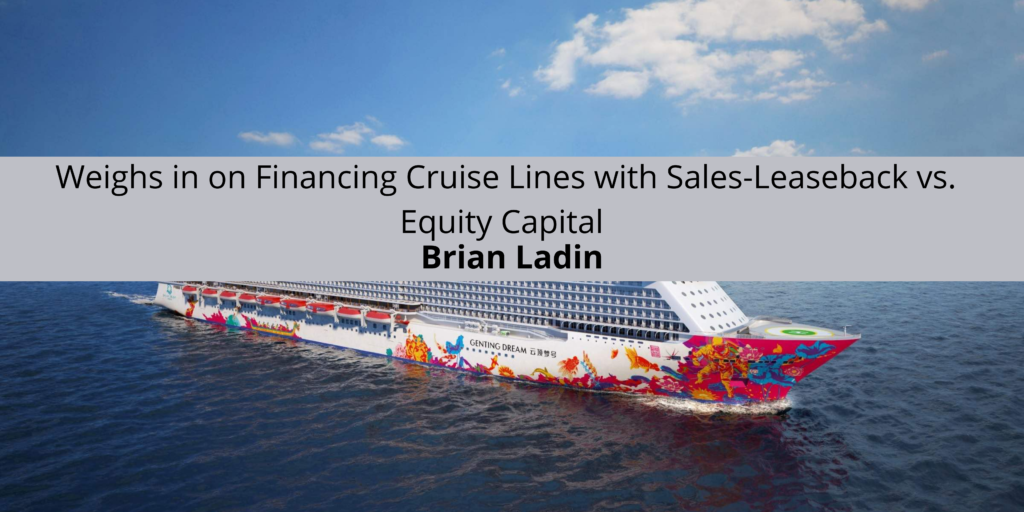Brian Ladin Weighs in on Financing Cruise Lines with Sales-Leaseback vs. Equity Capital


Financing a new cruise line involves million- and in some cases billion-dollar budgets. Cruise ships are expensive and feature the latest technologies. For new cruise lines, the finance model of equity capital may not always be the best option. Many new cruise lines are beginning to use the sale-leaseback model instead of equity capital when it comes to financing their operations. Brian Ladin of Delos Shipping in Dallas, TX explains the advantages of the sale-leaseback model over traditional equity capital financing and shares how this newer form of financing can help cruise lines thrive.
Modernization of the Cruise Ship Fleet
Cruise lines compete for customers using the newest innovations in vessel technology. To this end, new ships are continually being built by the world’s biggest cruise lines. Cruise tourism companies are always looking for the next form of amenity that will attract and retain customers. High-capacity cruise ships have become the wave of the future, with ships carrying up to 6,000 passengers and 200,000 Gross Tonnage becoming commonplace. Large cruise ships help to hold the cost per passenger down. Consolidation and globalization have marked the cruise ship market for several years.
Historical Sources of Cruise Ship Funding
The traditional method of funding cruise ships began in the 19th century. Steamships were the vessels of the day. In this historical period, the cruise ship was commonly financed in 64 equal shares, known as “sixty-fourth” company shares. Investors could acquire these shares and use them to bolster their portfolios. There were three primary groups of investors: individuals, partnerships, and joint stock companies. The majority of vessels were owned privately.
Ship sizes increased as the 20th century began, making joint stock companies more important in the financing of steamship lines. Public ownership of steamship lines meant that there was more transparency for the investor. Steamship operators preferred their dealings to remain private, so the family-owned or privately-owned model remained popular.
As the decades progressed, luxury ocean liners were replaced by modern cruise ships. These ships were more modern and traveled faster than their predecessors, making them attractive options for a vacation. The first modern cruise ship was built by the Norwegian Caribbean Line in 1966. This was followed by Carnival Cruise Lines and Royal Caribbean International. During this time period, most ships were financed by the first mortgage.
Today’s Cruise Ship Financing
Today, cruise lines have a range of options for acquiring capital. The company’s equity may be used, and bank loans may also take their place. Special purpose companies are also becoming important. Cruise lines cannot finance these multi-billion dollar ships on their own, meaning that some creative financing activities are necessary to survive.
The cost of building a cruise ship in today’s economy ranges from $500 million to $1.3 billion. Cruise ships use an astounding amount of capital, with financing ranges between 20 and 30 years. Companies purchasing new cruise ships need to diversify their funding sources for this reason.
While budgets are so high as to prevent the entire sum from being furnished through private funds, this historical funding method remains important in providing the balance of the investment. Bank financing can include such diverse methods as mortgage loans, corporate loans, shipyard credit, mezzanine finance, and private placement. Another method of finance for a new cruise liner is the public offering or bond issue.
Special purpose companies are beginning to take their place as crucial funding arms for the cruise ship industry. These are especially prevalent in new cruise lines which are just becoming established.
Cruise Ships are High-Risk Investments
Financing a modern cruise ship can be a financial strain on any cruise line, and new cruise companies are particularly vulnerable to this problem. Since the area of business is high-risk, banks and lenders have imposed many requirements on cruise lines needing funding for ship construction.
The complicated multi-national state of many cruise lines makes financing challenging. Cruise lines are frequently owned in international partnerships with many different tax requirements. This makes it difficult to get funding through traditional bank channels.
Large and established cruise lines are generally funded through public offerings. The companies are listed in the stock market in multiple countries. Public offerings mean that the company is less beholden to a bank or lender when it comes to making decisions about their money.
The Sale-Leaseback Model
The sale-leaseback model of cruise ship financing is simple to explain. In sale-leaseback financing, the cruise line sells the ship to another corporate entity and then leases it back in the long term. This allows a company to use the cruise ship without owning it. Leaseback transactions have significant tax and accounting advantages over other kinds of financing, which means that emerging cruise lines find this method especially helpful.
The sale-leaseback transaction sometimes happens when the owner of the cruise ship asset has financial difficulties. Instead of securing a loan or receiving outside funding, the cruise line is able to sell the ship to a private holding firm and continue to use it through leasebacks. Sale and leasebacks are also common in real estate investment trusts and in the aviation industry.
Cruise Ship Financing
Brian Ladin of Delos Shipping in Dallas, TX is an expert on the cruise industry. His deep understanding of the cruise and shipping industries make him an authority in the field. Sale and leaseback transactions are a vital way for emerging cruise lines to secure their investments. When new cruise lines use sale and leaseback techniques, they are less exposed to financial risk.

